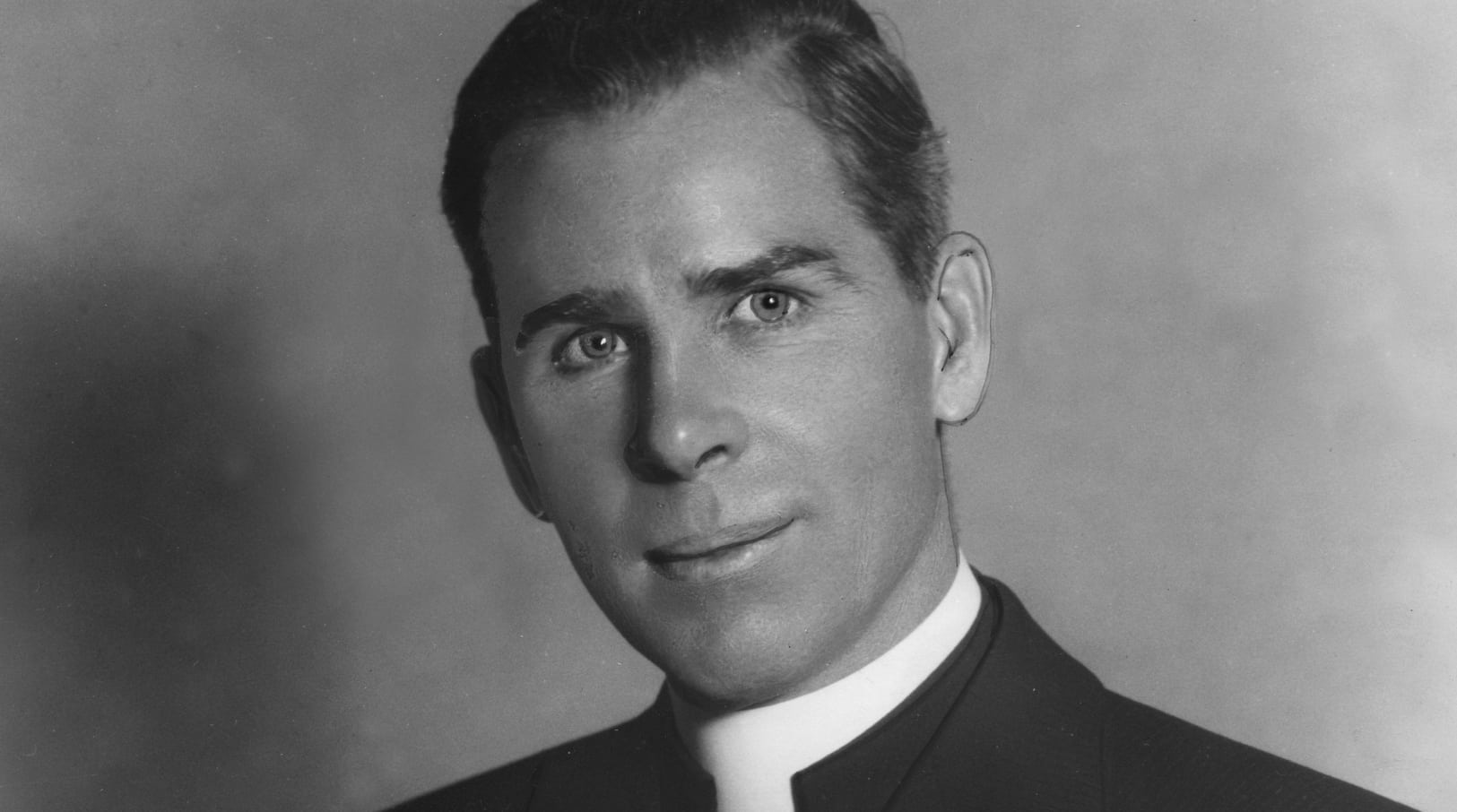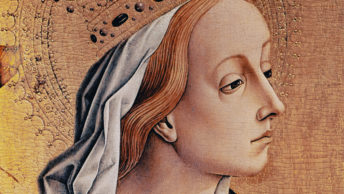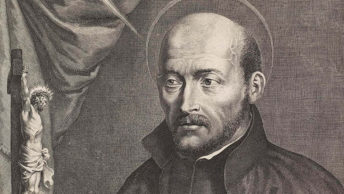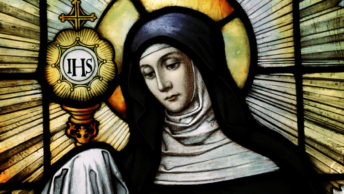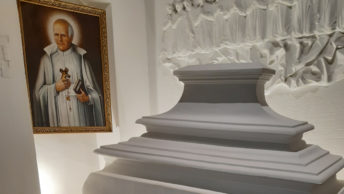When Pope Benedict XVI canonized seven new saints in Rome last October, two Americans, Kateri Tekakwitha and Marianne Cope, were among them. This brought the total of American saints to an even dozen with a number of holy luminaries waiting in the celestial wings, such as Dorothy Day, Pierre Toussaint, Cardinal Terence Cooke and Archbishop Fulton Sheen. Of these, the latter stands out for his fervent evangelization of God’s truth and his defense of the Church against atheistic communism.
The Face of the Church
A few generations ago Fulton J. Sheen was the face of the Church in America for millions of Catholics. His stentorian vocal cords echoed, not only throughout the rafters of many churches around the world, but on the airwaves of radio and TV. According to Archbishop Timothy M. Dolan of New York City, the common theme that emanated in all his preaching, writing, and speaking was that Jesus Christ was the way to heaven, the truth about how to get there, the life we hope to share for all eternity.
Sheen was born on May 8, 1895 in El Paso, Illinois, the oldest of four sons of Newton and Delia. Though he was baptized Peter John Sheen he was known as Fulton, his mother’s maiden name. After the family moved to nearby Peoria, Sheen took his first active role in his Church as an altar boy at St. Mary’s Cathedral. Given his intellectual brilliance, coupled with a powerful speaking voice, penetrating eyes and pleasing personality, it was not surprising that Sheen would go far in the Church. After his ordination in the Diocese of Peoria in 1919, he earned the prestigious Cardinal Mercier Prize for International Philosophy in 1923. This led to his appointment to teach theology and philosophy at Catholic University, a position he held from 1926 through 1950. During his academic period, Sheen matriculated at the prestigious Louvain University in Belgium where he earned his Ph.D. in philosophy with the highest honors.
His prominence increased after World War II when New York’s Cardinal Francis Spellman took Sheen under his wing. In 1950 Spellman named him to direct the Society for the Propagation of the Faith in the United States. The following year, the Cardinal made him an Auxiliary Bishop of the Archdiocese of New York. He held this position until 1966 when he was named the Bishop of Rochester. But the real story of Bishop Sheen’s journey toward canonization was not to be found in pastoral work or even in the university classroom.
Uncle Fultie
While clear and concise scholarship was his specialty–Sheen published the first of his 73 books in 1925–it was not in the classroom or even the traditional pulpit where Fulton J. Sheen would make his indelible mark on the Church. It was from the secular pulpit of mass communications that he did the most for the salvation of souls.
In 1928 Sheen began a weekly Sunday night radio broadcast, The Catholic Hour. He quickly became the program’s most popular preacher. Two decades later, his broadcast had a weekly listening audience of four million people. In 1946 Time magazine referred to him as the golden-voiced Msgr. Fulton J. Sheen, U.S. Catholicism’s famed proselytizer. In 1951, the DuMont Television Network produced a series of religious programs featuring a Protestant minister, a Jewish rabbi and a Catholic bishop, rotating on a weekly basis. While the other shows failed to attract listeners, Bishop Sheen’s segment, aptly called Life Is Worth Living, was a sensation.
Monsignor Sheen simply discussed the moral issues of the times in front of a live audience without script or cue cards. Above all it was Sheen’s engaging smile, bright eyes and profound wit that made him a media icon. The show was scheduled in the graveyard slot on Tuesday nights at 8:00 P.M., pitted against Mr. Television himself, comedian Milton Berle. After Sheen won an Emmy Award in 1952 as Most Outstanding Television Personality, his main competition, Milton Berle, known to his fans as Uncle Miltie, quipped that they both work for the same boss, Sky Chief Supreme. This was a reference to a grade of gasoline produced by Berle’s sponsor, Texaco. Not to be outdone, Sheen said people could start calling him Uncle Fultie.
Sheen’s topics scanned the Catholic landscape from Freudian psychiatry to the Irish sense of humor and the evils of communism. In a 1953 episode he narrated the burial scene from Julius Caesar, substituting Soviet leaders for Shakespeare’s characters. He then reminded his audience that Stalin must one day meet his eternal judgment. A week later, the Soviet dictator was dead from a stroke.
A New Messianism
Sheen recognized world communism as the greatest threat to Christianity. He constantly used his intellect and the power of his voice to combat it in his books and broadcast media. Both Karl Marx and Friedrich Engels had been educated in the Christian West. In his book Marxism, Communism and the Conscience of the West, Sheen argued that their ideology could not have been created apart from the Christian tradition. Sheen saw Marxist theory as a caricature of Christian doctrine, rationalized and secularized by men who grew up within the Church and who at times insisted they were speaking for the Church.
However, their philosophies were as disparate as St. Augustine’s City of God and Satan’s City of Man. The one similarity that intrigued Sheen the most was their doctrine of God, despite the fact that communism was officially atheistic. Sheen reasoned that whatever man put trust in, that was his god. The god of communism was history itself. Marxists believe that the historical process is a cosmic endocrine gland that secretes its own solutions as it goes along. Their god was eternally good because history was slowly progressing toward a classless utopia and a stateless society on earth.
Sheen believed that atheism was not just an esoteric philosophy preached by Ivy League professors but was a universal philosophy that had evolved into a New Messianism that threatened to cover the face of the earth. While America’s alliance with Russia mandated silence during the war years, Sheen was unsparing in his denunciation of the Kremlin’s Red Terror. He was painfully aware that communism was making profound gains among American women by liberating them from their faith, morals and often their families as it had done in the Soviet Union.
Brides of the State
Bishop Sheen considered women the barometers of Western Civilization. As mothers, teachers and nurturers they were the transmitters of a society’s culture. He knew the central paradox of the modern world was that women were glorified when they were successful in the marketplace but devalued when they produced human life. Sheen dated communism’s utilitarian subjection of women back to 18th-century France. During the French Revolution women had sacrificed their spiritual underpinnings and moral protections to the extent that they were helpless in the face of the machine age generations later. Their modern transformation from wives and mothers to brides of the state accelerated in America under President Lyndon Johnson’s welfare reforms which severely weakened the American family.
Sheen believed that advocates of equal rights for women saw equality in purely mathematical terms – e.g., access to the same jobs, pay and sexual freedoms as men. This contradicted Christianity, which stressed equality only in a proportional sense. Female mathematical equality effectively killed chivalrous respect and reduced women to little more than the instrument of man’s sexual pleasures.
The World’s First Love
Sheen taught that women set the standards of civilization. As he explained, there is an innate difference between knowing and loving. In knowing something, one brings it down to the level of his or her understanding. The abstract principles of physics can ordinarily only be understood by examples. Music lovers have to submit to its laws and disciplines. But a man in love will always reach up to meet the standards of his beloved. It then follows that the nobler the woman, the nobler the love. Consequently, the higher the demands by the woman, the worthier the man must be. In their relentless drive for equality feminists have lowered standards of conduct.
Sheen had a lifelong devotion to the Blessed Virgin Mary whom he referred to as the woman I love. Mary was the pinnacle of womanhood in her pure sacrifice and devotion to her family. Sheen’s love for the Blessed Mother was fully revealed in his book The World’s First Love. To Sheen Mary was the true inspiration of womanhood.
Mel Gibson’s 2005 film The Passion of the Christ beautifully communicated this idea. His film depicted Mary in such human and dolorous terms that one could see and feel her terrible pain. Her limitless love for her son in his dying moments stands as an inspiration to all women. Since the crucifixion Mary has been the model for a heroism that men can never approach. While men labor under the strains of business and even war, real women must stand by and wait. Women are always the ones closest to the Cross on Good Friday, and the first at the tomb on Easter morning.
Soul Peace
Bishop Sheen realized as a young priest that mankind was in a perennial state of agitation. In 1946, Dr. Joshua Liebman, the Rabbi of Temple Israel in Boston and a radio preacher, published a best-selling book on Freudianism called Peace of Mind. The rabbi theorized that post-war America was suffering from a prolonged state of Angst. Liebman believed that the country would be better served if Americans discarded any notion they had of sin, guilt, penance and the 10 Commandments.
Sheen answered all of Liebman’s scientific attacks on Christian morality in his book Peace of Soul. He explained inner human conflicts due to sin in terms of their metaphysical significance for the soul and its relationship with all-forgiving God. In doing so Sheen turned the tables on science’s assault on religion by explaining that a man hates religion because religion is the reminder of his guilt.
Sheen also debunked the rabbi’s assertion that psychoanalysis had something new and better to offer the public than the wisdom of the Church and her saints. Sheen stressed that in all of modern psychology there is nothing written on frustration, fears and anxieties which can even faintly compare in depth or breadth with St. Thomas’s treatise on the Passions, St. Augustine’s Confessions, or Bossuet’s treatise on Concupiscence. Sheen knew that there could never be world peace unless there was soul peace.
The Hound of Heaven
In addition to relieving the psychological conflicts that afflicted post-war Americans, Sheen also sought to extend the peace of Christ to millions of those outside his Church. His deep interest in converting non-Catholics and bringing lapsed Catholics back to the Church dated from his earliest years as a priest. Because of St. Paul’s dramatic conversion on the road to Damascus, Sheen believed that conversion was possible for any person because it is a response to the Holy Spirit, not the evangelizer.
Bishop Sheen knew he could not simply preach to the converted, but had to go out into the streets, the universities, and the world of radio and television to call the world to conversion. As the director of the Society for the Propagation of the Faith in the United States in 1950, Sheen began an association that brought many thousands of converts into the Catholic Church.
Sheen was well known for his celebrity converts. His impressive list of lapsed Catholics whom he guided back to the Church included columnist Heywood Broun, doctrinaire communists Elizabeth Bentley, Bella Dodd and Louis Budenz, industrialist Henry Ford II, the diplomat Clare Booth Luce, wife of Time/Life publisher Henry Luce, and comedian Jackie Gleason. These luminaries were merely the tip of an iceberg of Catholics who bent a supplicant knee under his charismatic sway.
A Saintly Voyage
The life of Fulton J. Sheen was a saintly voyage through the waves and rapids of the 20th century. His daily devotion to the Blessed Sacrament was a ritual he observed since his ordination. It provided him with the spiritual sustenance that his public life necessitated. It also energized and demonstrated the life of the Holy Spirit within him. During his hours of intimacy with the Lord, he deepened his love for God and followed Him as faithfully as any apostle or disciple.
The greatest obstacle to his spiritual perfection was his vanity, a flaw that he fought against every day of his adult life. His profound intelligence and wit often put him at odds with others, even a few superiors. His relationship with Cardinal Francis Spellman deteriorated to the extent that the Cardinal banished him to the diocese of Rochester, New York in 1966. Being a pastor of a diocese was a humbling experience for Sheen, but to his credit he threw his substantial energies into the task.
In Rochester he created the Sheen Ecumenical Housing Foundation. He also entered the political fray by opposing the Vietnam War in 1967 and was active in the civil rights movement. Both public stances alienated him from his flock, causing a period in his life that had to have a purgatorial effect on his soul. One month after celebrating his 50th anniversary as a priest, Sheen resigned as head of the Rochester Diocese and was summarily appointed Archbishop of the Titular See of Newport (Wales) by Pope Paul VI.
On October 2, 1979, Pope John Paul II visited St. Patrick’s Cathedral and embraced him, saying, You have written and spoken well of the Lord Jesus Christ. You are a loyal son of the Church. Two months later Sheen died of heart disease. He is buried in the crypt just behind the main altar in St. Patrick’s with the other deceased archbishops of New York City.
His exemplary life has not gone unnoticed. In 1998 Gregory J. Ladd and Lawrence F. Hickey established the Archbishop Fulton J. Sheen Foundation to remind the Catholic world of his saintly life. In 2002 the foundation opened its campaign, Sheen’s Cause for Canonization. A decade after Pope John Paul II avowed him a Servant of God, Pope Benedict XVI affirmed Archbishop Sheen as Venerable. Serious work has been going on to officially sanction two miracles under his influence. When this happens Fulton J. Sheen will be eternally known as a Saint of the Catholic Church. His Mother in Heaven will be most pleased.

